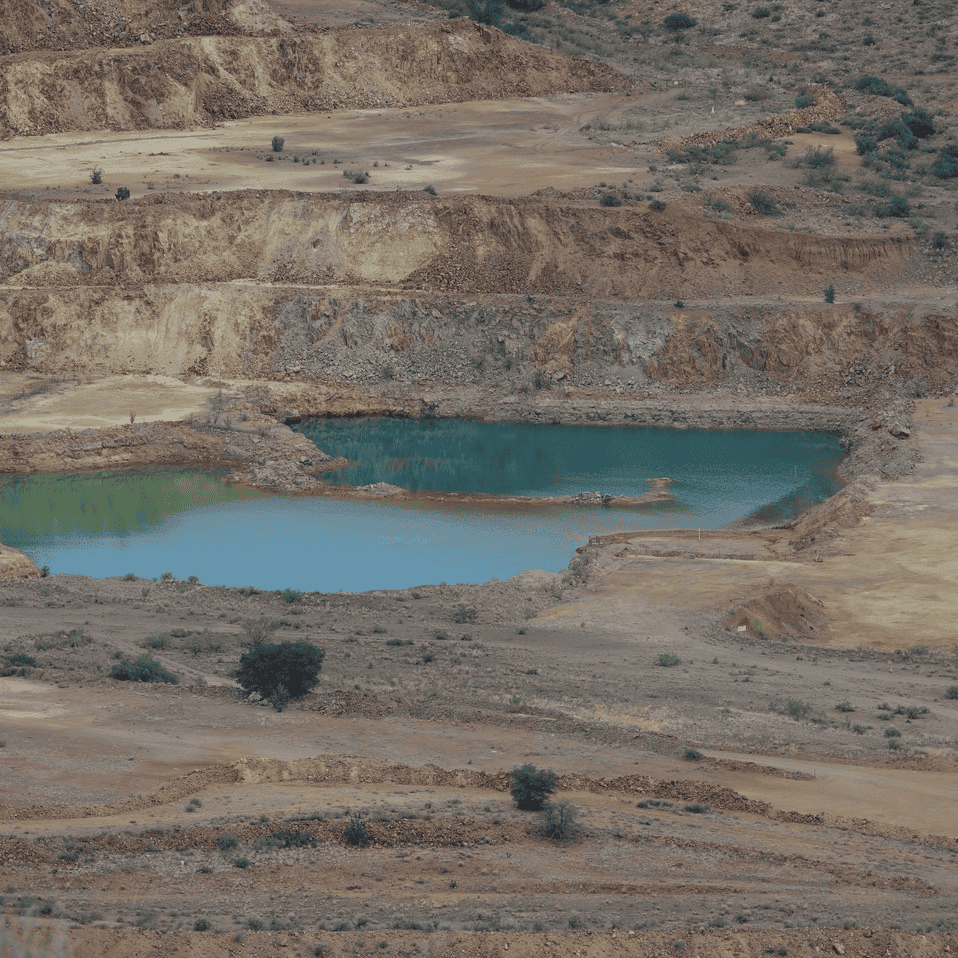We are still waiting for a decision on the mine’s protested application to transfer water rights from outside El Paso to Caballo to reopen Copper Flat Mine. I reported last summer on the hearings themselves, and in January I summarized the final submitted arguments of the so called “Hillsboro Protestants” (Hillsboro Pitchfork Ranch, PAWA, Sierra Club, and Gila River Information Project). Since I’ve just received the final submissions of all the other participants, their Findings of Fact, Conclusions of Law, post-Hearing closing Briefs, and Responses to each other, I thought it informative to report on these.
The short version of this report is just to say that all protesting parties (NM Interstate Stream Commission, the Water Rights Division of the Office of the State Engineer, the Hillsboro Protestants, Ladder Ranch, Camino Real Regional Utility Authority, Elephant Butte Irrigation District, Santa Teresa Land, Paseo del Norte, and Westpark) agree that the law requires the applicant of a transfer to show with a “preponderance of evidence” that the transfer will not impair other water rights, harm public welfare, and conserve water. They further agree that the mine’s lawyers have failed to do any of that.
Hillsboro made the most detailed examination of the potential harms of the transfer. Other arguments were quite short. CRRUA and the three Santa Teresa developers simply signed onto WRD’s brief; though CRRUA and the Santa Teresa entities also together filed a Supplemental Brief The ISC joined them in the Response after filing a separate, short argumentative Brief. The Ladder and EBID were outliers. EBID while agreeing with the others, focused its argument on the harms that the transfer would effect on the Rio Grande Project, the agreement between EBID, Texas Irrigation District, and Mexico on the distribution of the water behind Elephant Butte Dam. This agreement is different from, but related to, the Rio Grande Compact, which is an agreement between Colorado, New Mexico, Texas, and Mexico on the division of the river water among the states.
Surprisingly, the Ladder’s argument centered on the claim that the mine applied for the transfer to attract investors (“de-risk” investments, according to the mine’s Chief Operating Officer’s testimony) and not to use the water. This claim was repeated by the joint brief submitted by the WRD, CRRUA, and the Santa Teresa developers, which further accused the mine of “speculation” (a defined illegality in Colorado but somewhat ambiguous in New Mexico water law).
Just as surprisingly, the mine’s attorneys responded by calling the Ladder “dishonest.” The mine is understandably thrashing about looking for ways to defend its application against quite a large barrage of evidence and contentions. Their arguments, legal references, and responses make the most interesting reading if one is interested in legal strategies and their limits. Name calling is one of the expedients the mine uses. At least a page at the end of its post-Hearing closing Brief is devoted to a diatribe against the “nimbyism” of the Protestants (I guess that means me). A footnote defines the term as a kind of hypocrisy. The mine says we drive electric cars, install solar panels on our roofs, pat ourselves on the back for environmentalism while refusing to benefit the public by blocking a copper mine. I find it hard, though, to imagine the ISC or the WRD of the Office of the State Engineer as nimbys (not in my backyard).
Throughout these hearings and also in the water court litigation over the mine’s claimed ownership of water rights, their lawyers, Law and Resources Planning Associates, have shown a strategic interest in prestige, names, and perceptions. Its office occupies the complete penthouse of the tallest building in Albuquerque, and when I was deposed there, I had a commanding view of the whole city, horizon to horizon. Fourteen years ago when the OSE was deciding on the validity and quantity of the water rights at the center of this transfer application, LRPA, representing the then owners, hired the recently retired State Engineer as its expert to argue before his recent subordinates. The same former State Engineer served LRPA as expert witness in the water court litigation. He boosted the amount of water rights the mine claimed to own from some 6,000 AFY to 10,000 AFY. In the present hearing, LRPA presents as the mine’s expert witness on water rights the former director of the WRD. The mine’s hydrology expert is the state’s most prestigious hydrology consulting firm. They like to buy the best.
Thoughout the mine’s final submissions, great emphasis is laid on deference, which I suppose is what we owe the prestigious. How can, the mine argues, the hydrology of Hillsboro’s hydrologist whose models were developed in only a few months compare with the mine’s hydrological models which took the prestigious firm four years to create? Following the deference argument, the mine’s briefs tend to rely very heavily on the BLM’s ten-year-old study of the environmental impacts of the mining project. Everyone should simply bow to the authority of that document which culminated in the federal granting of a mining permit. Never mind that water is not federal but state business.
The mine’s other strategy to diffuse criticism is to deploy the promise. The mine promises to do everything right. Not enough water in this application to satisfy the BLM and the NM mining permits requirements? The mine will look for more water rights. The Rio Grande will be negatively impacted? The mine will get off-sets (even though the Hearing Officer has decreed that off-set discussion is beyond the pale because it requires approval in a separate proceeding).
However, amidst this thrashing about looking for arguments, the mine has indeed found something substantial, or potentially so. The Mine Dewatering Act presumably is about the dangers of open-pit mining to groundwater in the vicinity. A pit usually goes deep into groundwater so that in order to excavate the pit, groundwater that flows into it must be constantly pumped out (dewatered). That constant outflow of a large amount of water can harm nearby wells. The legislation intends to remove the burden on individuals to bring suit against offending mine. It requires a mine to apply for a permit from the State Engineer to dewater and, if the dewatering might harm wells, to provide a replacement water supply. The mine’s lawyers, however, have combed the act and argue that the act applies not just to dewatering, but to a mine’s overall water use and that replacement is an absolute right of the mine, which the well owner cannot refuse, the act allowing an eminent domain taking to provide for replacement.
This is a legal bombshell. If the interpretation is upheld, there can really never be an impairment since the mine’s right of replacement trumps every well owner’s right. Mining gets a Get Out of Jail card in New Mexico.
The interpretation cannot be judged at this level of administrative hearing. It needs the judgment of the appellate courts, and that ensures this case will be punted upwards in the judicial system.
I had thought that this case would set precedence because it will be significantly decided on the issues of welfare and conservation. However, the mine’s argument on the Mine Dewatering Act introduces a diversion from those issues.


Just a reminder, mining is one of the few industries available to employ people in rural New Mexico. Jobs are required for taxes to be collected, which our government seems to be very willing to collect without providing opportunities to grow the tax base. That’s okay, taxation is theft, so we don’t want taxes anyways. SMH…
Excellent article!
President Biden’s new legislation to promote electric vehicles will require tens of thousands of miles of copper wire. Solar panels required tons of silver and copper to be manufactured and installed to provide green energy. Where will all these raw materials be obtained if not from within our national borders? Will China offer low cost copper and silver? Will Mexico?
I can’t see another source, can you?
And, if my research is correct, you too can own a piece of Copper Flats Mine by purchasing MACQF on the OTC exchange. Good luck….
The Hearing is about water, not copper. One can certainly not want to lose one’s water and still recognize the need for copper. As they say in Mexico: “Sin oro, se vive; sin agua, se muere.” You can live without money, but without water you die.
You ask where copper will come from, and the answer is that right now it mostly comes from South America. And, there’s local copper right from Silver City. Copper Flat, relatively speaking, is a tiny mine, with very low quality ore, and not much of it, enough for about a decade of exploitation. In contrast, the mines at Silver have been going for centuries and are still yielding ore that is twice as rich. That means, Copper Flat is expensive and water intensive to mine. It is not very competitive. That is the reason that since the 50s it has only operated 3 months. That is also the reason the present owners can’t sell it in a decade of trying during historically high copper prices.
Copper also comes from recycling. The US was very into recycling for a while, but the number of plants have decreased. Just a few years ago there were miles of copper cable on the ground near Hillsboro. It may still be there. And, think of all the copper plumbing in houses. Much of that copper will need replacement because the solder used in early copper systems had lead in it. So, there are sources.
As for Themac shares, you are right. Now is the time to buy since they have dropped from several dollars a share to 2 Canadian pennies today. You can hardly find Canadian pennies any more since Canada stopped minting them a decade ago, but if you find them, I assume they are the post-1997 steel or zinc pennies rather than the earlier copper pennies that are now collectors’ items.
Max Yeh has done it again in that he has explained what is going on with the Copper Flat Mine’s request to reopen, get enough water to do so…. I am a resident of Hillsboro. We have been in an extreme drought for at least the past nine years. If the amount of water the mine NEEDS to function properly is ever granted, my existence here, where I have lived for 31 years will, indeed, be in jeopardy. That amount would suck many wells in my town dry. Are a few (and I mean a FEW) local jobs worth that to the city of TorC? I don’t think so. So the local job plea doesn’t really work. Many of us believe the mine is mainly looking for water rights, a bigger commodity than copper. And yes, they have the $ to take this on for a long time. It already has cost us litigants more $ than we thought and has dragged on for so long, some have already moved away or died or…. The rest of us are here for the duration and to us, the idea that the state of NM would grant the mine the right to reopen flabberghasts us. It IS the water. We NEED it to live. As they say: WATER IS LIFE.
A big thanks to Mr. Yeh and his diligent work on the behalf of so many who would be at risk if this mine reopened.
water is so precious here i am shocked that more people aren’t concerned… mining is a rough career that is very hard on your body & not necessarily well paid~ & at the end of the day, if there is no drinkable water, everything else is moot